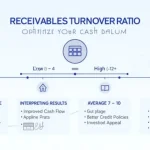Average Collection Period Calculator
Is this tool helpful?
Average Collection Period Calculator: Optimize Your Accounts Receivable Management
How to Use the Average Collection Period Calculator Effectively
The Average Collection Period Calculator is a powerful tool designed to help businesses streamline their accounts receivable management. To use this calculator effectively, follow these simple steps:
- Locate the “Receivables Turnover Ratio” input field on the calculator.
- Enter your company’s receivables turnover ratio. This is typically calculated by dividing net credit sales by average accounts receivable.
- Click the “Calculate” button to generate your average collection period.
- Review the result, which will be displayed in days.
For optimal results, ensure that you’re using accurate and up-to-date financial data. Regular use of this calculator can provide valuable insights into your business’s cash flow management and customer payment behavior.
Understanding the Average Collection Period: Definition, Purpose, and Benefits
The average collection period is a crucial financial metric that measures the average number of days it takes a company to collect payment for sales made on credit. This powerful indicator provides invaluable insights into a business’s accounts receivable efficiency and overall cash flow management.
The formula for calculating the average collection period is:
$$ \text{Average Collection Period} = \frac{365}{\text{Receivables Turnover Ratio}} $$
Where the receivables turnover ratio is calculated as:
$$ \text{Receivables Turnover Ratio} = \frac{\text{Net Credit Sales}}{\text{Average Accounts Receivable}} $$
The primary purpose of tracking the average collection period is to evaluate the effectiveness of a company’s credit and collection policies. By understanding how long it takes, on average, to collect payments from customers, businesses can make informed decisions to optimize their working capital management.
Key Benefits of Monitoring Average Collection Period
- Improved cash flow management: By tracking this metric, businesses can better predict when they’ll receive payments, allowing for more accurate cash flow forecasting.
- Enhanced credit policy evaluation: The average collection period helps companies assess the effectiveness of their credit terms and collection practices.
- Identification of payment trends: Regularly calculating this metric can reveal patterns in customer payment behavior, enabling proactive measures to address potential issues.
- Benchmarking performance: Companies can compare their average collection period to industry standards to gauge their relative efficiency in managing accounts receivable.
- Facilitation of strategic decision-making: Armed with this information, businesses can make informed choices about credit policies, customer relationships, and working capital allocation.
The Benefits of Using the Average Collection Period Calculator
Incorporating the Average Collection Period Calculator into your financial analysis toolkit offers numerous advantages for businesses of all sizes. Let’s explore the key benefits:
1. Time-Saving Efficiency
Manual calculations of financial metrics can be time-consuming and prone to errors. Our calculator automates the process, providing instant results with minimal input required. This efficiency allows financial professionals to focus on analyzing the results rather than spending time on complex calculations.
2. Accuracy and Consistency
Human error is a common issue when dealing with financial calculations. The Average Collection Period Calculator eliminates this risk by ensuring consistent and accurate results every time. This reliability is crucial for making informed business decisions based on dependable data.
3. Accessibility and User-Friendly Design
Our calculator features an intuitive interface that makes it accessible to users with varying levels of financial expertise. Whether you’re a seasoned CFO or a small business owner new to financial analysis, you can easily input your data and interpret the results.
4. Real-Time Insights
With the ability to quickly recalculate the average collection period as new data becomes available, businesses can gain real-time insights into their accounts receivable performance. This agility allows for timely adjustments to credit policies and collection strategies.
5. Improved Financial Planning
By regularly using the calculator to track the average collection period, companies can better forecast cash inflows and plan for future financial needs. This improved visibility contributes to more effective budgeting and resource allocation.
6. Enhanced Decision-Making
The calculator provides a clear, quantitative measure of accounts receivable efficiency. This objective data empowers management to make informed decisions about credit terms, collection procedures, and customer relationships.
Addressing User Needs and Solving Specific Problems
The Average Collection Period Calculator addresses several critical needs for businesses managing accounts receivable:
Cash Flow Management
For companies struggling with cash flow issues, the calculator offers a quick way to assess how efficiently they’re collecting payments. By identifying a high average collection period, businesses can take steps to accelerate cash inflows and improve overall liquidity.
Credit Policy Optimization
Businesses unsure about the effectiveness of their credit terms can use the calculator to evaluate the impact of different policies. By comparing the average collection period before and after policy changes, companies can fine-tune their approach to customer credit.
Performance Benchmarking
For organizations looking to gauge their performance against industry standards, the calculator provides a standardized metric for comparison. This benchmarking can highlight areas for improvement and help set realistic goals for accounts receivable management.
Early Warning System
A sudden increase in the average collection period can serve as an early warning sign of potential issues with customer payments or economic downturns. By regularly using the calculator, businesses can detect these changes early and take proactive measures.
Resource Allocation
Companies struggling with efficient resource allocation can use the insights gained from the calculator to determine if more staff or technology investments are needed in their accounts receivable department.
Practical Applications and Use Cases
To illustrate the practical value of the Average Collection Period Calculator, let’s explore some real-world scenarios:
Scenario 1: Retail Company Evaluating Credit Terms
A mid-sized retail company is considering extending its payment terms from 30 to 45 days to attract more customers. Using the calculator, they determine their current average collection period is 40 days with a receivables turnover ratio of 9.125.
After implementing the new terms, they recalculate and find the average collection period has increased to 52 days (receivables turnover ratio of 7). This information helps them assess whether the increased sales from the new terms outweigh the longer cash conversion cycle.
Scenario 2: Manufacturing Firm Benchmarking Performance
A manufacturing company wants to compare its accounts receivable efficiency to industry standards. They use the calculator and find their average collection period is 60 days (receivables turnover ratio of 6.08). Research shows the industry average is 45 days.
Armed with this information, the company investigates its collection processes and credit policies to identify areas for improvement, aiming to align more closely with industry benchmarks.
Scenario 3: Service Provider Improving Cash Flow
A small consulting firm is experiencing cash flow issues and needs to improve its working capital management. Using the calculator, they discover their average collection period is 75 days (receivables turnover ratio of 4.87).
Recognizing this as a potential source of their cash flow problems, they implement stricter credit checks, offer early payment discounts, and improve their invoicing process. After six months, they recalculate and find their average collection period has decreased to 50 days (receivables turnover ratio of 7.3), significantly improving their cash position.
Frequently Asked Questions (FAQ)
Q1: What is a good average collection period?
A: The ideal average collection period varies by industry and business model. Generally, a lower number is better as it indicates faster payment collection. However, it’s essential to balance quick collections with customer satisfaction and competitive credit terms. Compare your results to industry benchmarks for a more accurate assessment.
Q2: How often should I calculate the average collection period?
A: It’s recommended to calculate this metric at least quarterly. However, businesses with high transaction volumes or those experiencing cash flow issues may benefit from monthly calculations. Regular monitoring allows for timely identification of trends and potential problems.
Q3: Can the average collection period be too low?
A: While a low average collection period generally indicates efficient receivables management, an extremely low figure might suggest overly strict credit policies. This could potentially limit sales growth by discouraging customers who prefer longer payment terms. It’s crucial to find a balance that supports both healthy cash flow and business growth.
Q4: How can I improve my average collection period?
A: To reduce your average collection period, consider implementing the following strategies:
- Offer early payment discounts
- Streamline your invoicing process
- Implement stricter credit checks for new customers
- Use automated reminders for overdue payments
- Consider factoring or invoice financing for immediate cash flow
Q5: How does the average collection period relate to the cash conversion cycle?
A: The average collection period is a component of the cash conversion cycle, which measures how long it takes for a company to convert its investments in inventory and other resources into cash flows from sales. A shorter average collection period contributes to a shorter cash conversion cycle, generally indicating more efficient cash flow management.
Conclusion: Maximizing the Benefits of the Average Collection Period Calculator
The Average Collection Period Calculator is an indispensable tool for businesses seeking to optimize their accounts receivable management and improve overall financial health. By providing quick, accurate insights into the efficiency of payment collection processes, this calculator empowers companies to make data-driven decisions that enhance cash flow, refine credit policies, and ultimately drive business growth.
Key takeaways from using this calculator include:
- Gaining a clear understanding of your company’s accounts receivable efficiency
- Identifying trends in customer payment behavior
- Benchmarking performance against industry standards
- Facilitating informed decision-making regarding credit policies and collection strategies
- Improving cash flow forecasting and working capital management
To fully leverage the power of the Average Collection Period Calculator, make it a regular part of your financial analysis routine. Combine the insights gained from this tool with other financial metrics and industry knowledge to develop a comprehensive approach to managing your accounts receivable.
Take action today: Use the Average Collection Period Calculator to assess your current performance, set improvement goals, and monitor your progress over time. By consistently applying the insights gained from this powerful tool, you’ll be well-positioned to optimize your working capital, enhance customer relationships, and drive sustainable business growth.
Important Disclaimer
The calculations, results, and content provided by our tools are not guaranteed to be accurate, complete, or reliable. Users are responsible for verifying and interpreting the results. Our content and tools may contain errors, biases, or inconsistencies. We reserve the right to save inputs and outputs from our tools for the purposes of error debugging, bias identification, and performance improvement. External companies providing AI models used in our tools may also save and process data in accordance with their own policies. By using our tools, you consent to this data collection and processing. We reserve the right to limit the usage of our tools based on current usability factors. By using our tools, you acknowledge that you have read, understood, and agreed to this disclaimer. You accept the inherent risks and limitations associated with the use of our tools and services.







